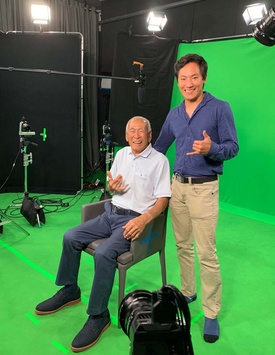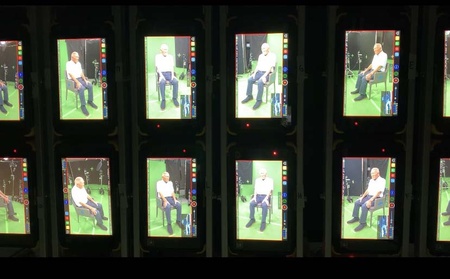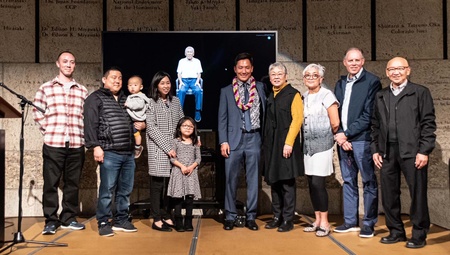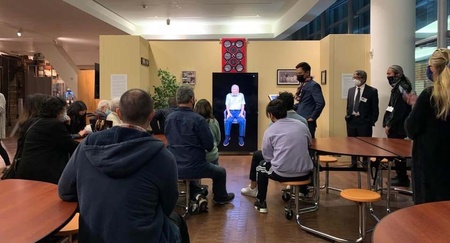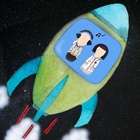“A snapshot of human memory.”
That’s what 23-year-old Cole Kawana likes to call one of the Japanese American National Museum’s newest exhibits, The Interactive StoryFile of Lawson Iichiro Sakai.
Kawana, a recent graduate from the University of Southern California and a 5th generation Japanese American, envisioned the technology-based project in 2019. As the founder and president of Japanese American Stories—a nonprofit that develops artificial intelligence avatars to help preserve and share the oral histories of Japanese Americans who lived through World War II—Kawana worked extensively with StoryFile Inc. to produce the immersive exhibit.
Among his list of duties: raising funds, consulting with an advisory board, and, ultimately, donating the project to the Japanese American National Museum.
The exhibit highlights Lawson Iichiro Sakai, who served with the 442nd Infantry Regiment during World War II. By utilizing artificial intelligence to foster a highly interactive environment, visitors can chat with Sakai in a conversational question-and-answer format about any topic they can imagine.
“Where were you born?” and “What was it like to lose fellow soldiers?” are among some of the questions that Sakai can answer. However, Kawana reports that 1000 questions were asked during the intensive 9 to 5 weeklong interview to gather the full, inclusive scope of the veteran’s life story. The AI was then trained to respond to 15 to 50 iterations of each of those 1,000 questions.
Visitors initiate the discussion by either verbally stating or typing their questions into a museum-supplied tablet, while taped recordings of Sakai match themselves to their inquiries accordingly. The result: a casual, yet life-like exchange with a World War II veteran.
But the depth and candidness of Sakai’s answers is something that Kawana recounts as stirring.
Although Sakai passed in 2020, just a year short of the exhibit’s official museum opening, his family was able to reconnect with him through the power of artificial intelligence in a private screening.
“They were able to talk to their family members that they hadn’t talked to in a year or so,” says Kawana, “When they asked him some questions, he told them stories that he never told them while he was alive. And that just blew me away.”
In addition to his interview work with Sakai, Kawana himself holds a long, personal history with recording the testimonies of other Japanese Americans. An oral historian hired to document his relatives’ lives at a family reunion piqued the interest of Kawana, who was then in the 5th grade. As family members were, one-by-one, pulled aside to recite their stories to the camera, his fascination with the recording technology and process quickly took root.
The following year, Kawana sought to delve deeper into documenting by creating an instructional tutorial on how to record oral histories at home for students his age. Kawana also began to take his own shot at recording testimonies. Along with his paternal grandfather, he interviewed his great uncle Arthur Ichiro Murakami—an American student living in Japan who survived the Hiroshima atomic bombing. The recording was displayed at JANM in 2010 and later archived at the Hiroshima Peace Memorial Museum.
Kawana’s history with the Japanese American National Museum is extensive and holds an impressive multigenerational status as well.
While his grandparents Richard and Masako Koga Murakami have been long-time supporters, with Masako being the first volunteer, he mentions that his mother raised funds for the museum’s first tape recorder. Immersed in the rich cultural ambiance of JANM and its home of Little Tokyo, Kawana reminisces about the days of searching for his name etched on the museum’s pavers and attending the annual Nisei Week festival. “My exposure to Japanese American culture,” he emphasizes, “Is all through my family.”
Being so in-tune with Japanese American affairs, it wasn’t difficult for Kawana to eventually spot a deficiency in his education.
“When I was in high school and got to the section on the internment camps, it was about a paragraph, and we spent about five minutes on it. I was blown away because this is something that's so huge in my life, and it was barely mentioned.”
Later involvement with the USC Shoah Foundation immersed Kawana in work with Holocaust survivors, educational packages for high school students, and experimental AI technology. However, realizing the urgent need to document the wartime stories of aging Japanese American populations for future generations, Kawana began to draw upon his experiences from his time with the Shoah Foundation to shine a light on Japanese American oral history.
From there, Kawana founded Japanese American Stories, started work with Lawson Sakai, and the rest was history.
Today, the USC graduate remains busy with nonprofit work and his other passion – hydrofoiling. Along with Japanese American Stories and his other nonprofit, he is active in the Clean Water Ambassador Foundation, which aims to deliver drinking water to those in need. He said that he is also currently wrapping up a semi-professional hydrofoil surfing career in Hawaii.
Kawana also remains hopeful for the trajectory of the Lawson Sakai project and AI technology in the years to come. The exhibit is even said to harbor the potential for a 3D, holographic projection of Sakai in the future.
However, the project’s true strength, he says, is the exhibit’s accessibility within the classroom setting. By accessing the interview materials and technology online, Kawana voices that students can gain much more from a discussion with Sakai than a “little five-minute anecdote in the history book.”
“The AI and holographic technology are complicated, but the end goal of all of this technology is for it to melt away. At the end of the day, we are just trying to emulate and preserve person-to-person conversation. I want kids in 50 years to be able to have conversations with someone that was present for the history they are reading about. It’s one thing to read about internment camps or WWII in a book, [but] it’s an entirely different empathetic experience to talk to someone that experienced it firsthand.”
Whether it is in the museum or in the classroom, Cole Kawana hopes that the Interactive StoryFile of Lawson Iichiro Sakai will give Japanese American history a voice, one conversation at a time.
The Interactive StoryFile of Lawson Iichiro Sakai opened on November 30, 2021, and will be once again available to the public when the Japanese American National Museum reopens.
© 2022 Kyra Karatsu


